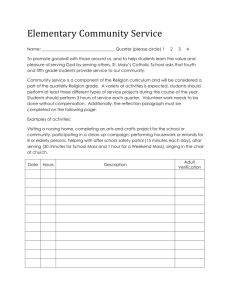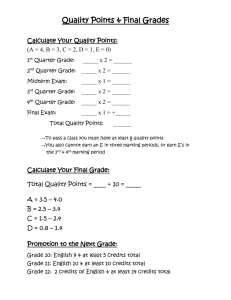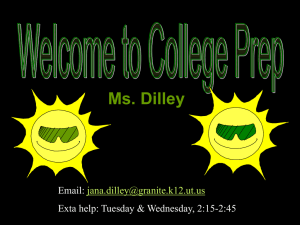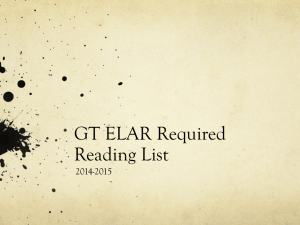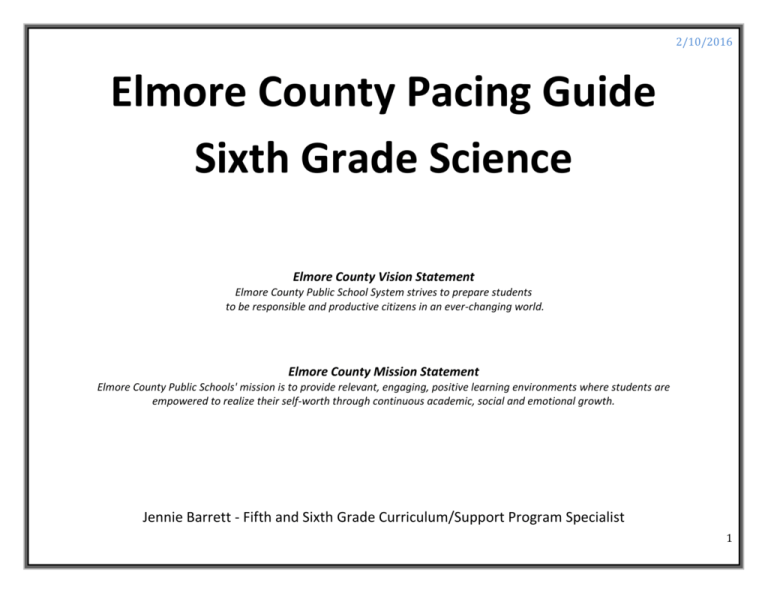
2/10/2016
Elmore County Pacing Guide
Sixth Grade Science
Elmore County Vision Statement
Elmore County Public School System strives to prepare students
to be responsible and productive citizens in an ever-changing world.
Elmore County Mission Statement
Elmore County Public Schools' mission is to provide relevant, engaging, positive learning environments where students are
empowered to realize their self-worth through continuous academic, social and emotional growth.
Jennie Barrett - Fifth and Sixth Grade Curriculum/Support Program Specialist
1
2/10/2016
Elmore County Sixth Grade Science Pacing Guide
Quarter 1
Alignment to Pearson/Prentice Hall Science, Science Modules, GLOBE, and “Fill in the Holes” Activities
www.amsti.org (additional resources)
Timeline
ALCOS Standard
AMSTI Lessons
Textbook Resources
First Week of School
Scientific Process and Application Skills (ALCOS pp. 9-10)
Science Fair in February
Quarter 1
8. Describe how Earth’s rotation, Earth’s axial tilt, and
RSS- Lessons 1, 2, 3, 10
Ch. 18, Section 1, pp.
Researching the Sun, distance from the equator cause variations in the heating
614-621
Moon, Earth System and cooling of various locations on Earth.
(RSS)
Ch. 19, p. 660
Quarter 1
9. Identify the moon’s phases.
RSS- Lessons 4, 7, 10
Ch. 19, Section 3, pp.
Researching the Sun,
670-683
Moon, Earth System
Describing lunar and solar eclipses
(RSS)
Relating effects of the moon’s
positions on oceanic tides
2
2/10/2016
Elmore County Sixth Grade Science Pacing Guide
Quarter 2
Exploring the Planetary
Systems
(EPS)
Quarter 2
Exploring the Planetary
Systems
(EPS)
Quarter 2
Exploring the Planetary
Systems
(EPS)
Quarter 2
Exploring the Planetary
Systems
(EPS)
Quarter 2
Exploring the Planetary
Systems
(EPS)
Quarter 2
Quarter 2
10. Describe components of the universe and their
relationships to each other, including stars, planets and
their moons, solar systems, and galaxies.
Identifying the impact of space exploration on
innovations in technology
EPS- Lessons 1, 2, 3, 4, 5, 6,
7, 8, 9, 10
RSS- Lessons 1, 2, 3, 4, 5, 6, 7,
8, 9, 10
UWC- Lessons 1, 10
RSS- Lessons 5, 10
Examples: MRI, microwave, satellite imagery, GPS
RSS- Lesson 3, 10
Mapping seasonal changes in locations of
constellation in the night sky
Describing the life cycle of a star
Quarter 2
Ch. 19, pp. 658-697
Ch. 20, pp. 700-742
Ch. 21, pp. 742-781
Ch. 19, pp. 658-697
Ch. 20, pp. 700-741
Ch. 21, pp. 742-781
Ch. 21, p. 742
Fill in the Holes- “Life Cycle
of a Star Activity”
Ch. 21
11. Describe units used to measure distance in space,
including astronomical units and light years.
EPS- Lessons 1, 2, 10
Ch. 21
5. Describe layers of the oceanic hydrosphere, including
the pelagic zone, benthic zone, abyssal zone, and
intertidal zone.
UWC- Lesson 8
Ch. 14, pp. 470-496
Fill in the Holes- “Water,
Water Everywhere”
GLOBE Year Two
UWC- Lesson 8
Fill in the Holes- “Water,
Water Everywhere”
GLOBE Year Two
Ch. 14, pp. 470-496
Example: H-R diagram
6. Describe regions of the oceanic lithosphere, including
the continental shelf, continental slope, and abyssal zone
plain.
3
2/10/2016
Elmore County Sixth Grade Pacing Guide
Quarter 3
Understanding
Weather and Climate
(UWC)
1. Identify global patterns of atmospheric movement,
including El Nino, the Gulf Streams, the jet stream,
the Coriolis Effect, and global winds that influence
local weather.
Quarter 3
UWC- Lesson 9
EPT- Lesson 14
GLOBE Year One
Ch. 16, p. 556
UWC- Lessons 3, 5,6
Ch. 17, pp. 578-599
Quarter 3
Understanding
Weather and Climate
(UWC)
Quarter 3
Understanding
Weather and Climate
(UWC)
UWC- Lessons 2,4,6,10,11
Describing the function of instruments and
technology used to investigate Earth’s weather,
including barometers, thermometers, wind socks,
weather vanes, satellites, radar, weather balloons,
and rain gauges
Quarter 3
Understanding
Weather and Climate
(UWC)
Using lines of latitude and longitude to locate
areas of specific weather events
UWC- Lessons 4, 7
Ch. 16, p. 556
Quarter 3
Understanding
Weather and Climate
(UWC)
Interpreting weather data through observations
collected over time
Example: calculating annual precipitation and
average temperature
UWC- Lessons 6,10,11,12
Ch. 16, p. 556
Ch. 17, pp. 578-599
UWC- Lessons 6, 11
Ch. 16, pp. 540-575
Quarter 3
Understanding
Weather and Climate
(UWC)
Predicting local weather and weather patterns
Examples: cold and warm fronts high and low
pressure areas
3. Describe water and carbon biogeochemical cycles and
their effects on Earth.
Ch. 15, p. 516
Fill in the Holes- “The Carbon
Cycle Game”
4
2/10/2016
Elmore County Sixth Grade Science Pacing Guide
Quarter 3
Understanding
Weather and Climate
(UWC)
Quarter 3
Understanding
Weather and Climate
(UWC)
7. Describe Earth’s biomes.
Examples: aquatic biomes, grasslands, deserts,
chaparrals, taigas, tundras
Identifying geographic factors that cause diversity
in flora and fauna, including elevation, location,
and climate
Quarter 3
Fill in the Holes- “Biomes of
the World”
GLOBE Year Two
Ch. 12, 13, 14
Fill in the Holes- “Biomes of
the World”
GLOBE Year Two
GLOBE Information
AMSTI
5
2/10/2016
Elmore County Sixth Grade Pacing Guide
Quarter 4
Exploring Plate
Techtonics
(EPT)
Quarter 4
Exploring Plate
Techtonics
(EPT)
Quarter 4
Exploring Plate
Techtonics
(EPT)
Quarter 4
Exploring Plate
Techtonics
(EPT)
Quarter 4
Exploring Plate
Techtonics
(EPT)
Quarter 4
Exploring Plate
Techtonics
(EPT)
2. Describe factors that cause changes to Earth’s surface
over time.
Examples: earthquakes, volcanoes, weathering,
erosion, glacial erosion or scouring, deposition,
water flow, tornadoes, hurricanes, farming and
conservation, mining and reclamation,
deforestation and reforestation, waste disposal,
global climate changes, greenhouse gases
Comparing constructive and destructive natural
processes and their effects on land formations
Examples: constructive- volcanic and mountain
building processes; destructive- erosion by wind,
water, and ice
Distinguishing rock strata by geologic composition
Examples: predicting relative age of strata by
fossil depth, predicting occurrence of natural
events by rock composition in a particular strata
4. Explain the plate tectonic theory.
Example: using terminology such as continental drift,
Quarter 4
UWC- Lessons 5, 9, 10, 11, 12 Ch. 9, pp. 266-269
EPT- Lessons 4, 5, 6, 7, 9, 10
EPS- Lessons 5, 6, 8, 9, 10
UWC- Lessons 2, 7, 11, 12
EPT- Lessons 1, 2,3, 4, 6, 7, 9,
10, 11, 13, 14
EPS- Lessons 6, 10
Ch. 1, p. 14
EPT- Lesson 13
EPS- Lessons 9, 10
Ch. 10, pp. 308-321
EPT-Lessons 2, 3, 5, 8, 10
EPS- Lesson 10
Ch. 5, pp. 122-154
seafloor spreading, lava, magma, eruption, epicenter,
focus, seismic wave, and subduction zone
Describing types of volcanoes and faults
EPT-Lessons 7, 9, 10, 11, 12
EPS- Lesson 10
Ch. 6,
Ch. 7, pp. 200-223
Determining energy release through
seismographic data
Example: using data from the Mercalli scale and
the Richter scale
EPT- Lessons 1, 3, 4
Ch. 6, pp. 169-185
Ch. 6, Section 2
6




